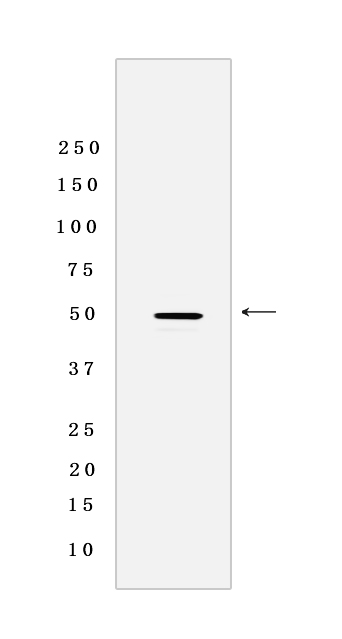WIPI1 Rabbit mAb [X7U6]Cat NO.: A45935
Western blot analysis of extracts from A375 cells lyastes.using WIPI1 Rabbit mAb [X7U6] at dilution of 1:1000 incubated at 4℃ over night
Product information
Protein names :WIPI1,WIPI49,WIPI1_HUMAN,WD repeat domain phosphoinositide-interacting protein 1
UniProtID :Q5MNZ9
MASS(da) :48,673
MW(kDa) :49 kDa
Form :Liquid
Purification :Protein A purification
Host :Rabbit
Isotype :IgG
sensitivity :Endogenous
Reactivity :Human,Mouse,Rat
- ApplicationDilution
- 免疫印迹(WB)1:1000-2000
- 免疫组化(IHC)1:100,
- The optimal dilutions should be determined by the end user
Specificity :Antibody is produced by immunizing animals with a synthetic peptide of Human WIPI1.
Storage :Antibody store in 10 mM PBS, 0.5mg/ml BSA, 50% glycerol. Shipped at 4°C. Store at-20°C or -80°C. Products are valid for one natural year of receipt.Avoid repeated freeze / thaw cycles.
WB Positive detected :A375 cells lyastes
Function : Component of the autophagy machinery that controls the major intracellular degradation process by which cytoplasmic materials are packaged into autophagosomes and delivered to lysosomes for degradation (PubMed:15602573, PubMed:20114074, PubMed:20484055, PubMed:20639694, PubMed:23088497, PubMed:28561066, PubMed:31271352). Plays an important role in starvation- and calcium-mediated autophagy, as well as in mitophagy (PubMed:28561066). Functions downstream of the ULK1 and PI3-kinases that produce phosphatidylinositol 3-phosphate (PtdIns3P) on membranes of the endoplasmic reticulum once activated (PubMed:28561066). Binds phosphatidylinositol 3-phosphate (PtdIns3P), and maybe other phosphoinositides including PtdIns3,5P2 and PtdIns5P, and is recruited to phagophore assembly sites at the endoplasmic reticulum membranes (PubMed:28561066, PubMed:31271352, PubMed:33499712). There, it assists WIPI2 in the recruitment of ATG12-ATG5-ATG16L1, a complex that directly controls the elongation of the nascent autophagosomal membrane (PubMed:28561066). Together with WDR45/WIPI4, promotes ATG2 (ATG2A or ATG2B)-mediated lipid transfer by enhancing ATG2-association with phosphatidylinositol 3-monophosphate (PI3P)-containing membranes (PubMed:31271352). Involved in xenophagy of Staphylococcus aureus (PubMed:22829830). Invading S.aureus cells become entrapped in autophagosome-like WIPI1 positive vesicles targeted for lysosomal degradation (PubMed:22829830). Plays also a distinct role in controlling the transcription of melanogenic enzymes and melanosome maturation, a process that is distinct from starvation-induced autophagy (PubMed:21317285). May also regulate the trafficking of proteins involved in the mannose-6-phosphate receptor (MPR) recycling pathway (PubMed:15020712)..
Tissue specificity :Ubiquitously expressed. Highly expressed in skeletal muscle, heart, testis, pancreas and placenta. Highly expressed in G361, Sk-mel-28, Sk-mel-13, WM852 and WM451 cells. Up-regulated in a variety of tumor tissues..
Subcellular locationi :Golgi apparatus, trans-Golgi network. Endosome. Cytoplasmic vesicle, clathrin-coated vesicle. Preautophagosomal structure membrane,Peripheral membrane protein. Cytoplasm, cytoskeleton.
IMPORTANT: For western blots, incubate membrane with diluted primary antibody in 1% w/v BSA, 1X TBST at 4°C overnight.


